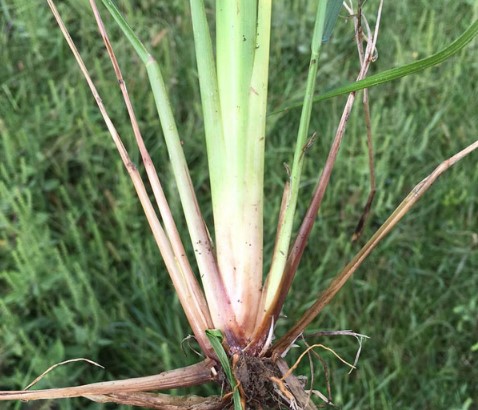By Kevin Bradley, Anthony Ohmes.et.al
In recent years, we have received a number of complaints and calls about a grass that is starting to invade some pastures and roadsides in Missouri. The grass is called Chinese fountain grass, Pennisetum alopecuroides (figure 1). Cultivars of this grass such as 'Hameln' and 'Little Bunny' are commonly sold in the landscape industry because of their ornamental appeal (figure 2). However, the high degree of sterility in these cultivars causes them to be considered non-invasive, unlike Chinese fountain grass. Purple fountain grass (Pennisetum setaceum 'Rubrum') is also a popular related species. However, it is not considered to be winter hardy north of zone nine. Thus far, we have encountered Chinese fountain grass occurring as a weed in a pasture or roadside setting in Cape Girardeau, Perry, Madison, Greene and Barry counties in Missouri.
Figure 1 A Chinese fountain grass plant in a tall fescue pasture in Cape Girardeau, Missouri.
Figure 2 Hameln' is a very popular cultivar of Chinese fountain grass in the ornamental plant industry but is not considered to be invasive because of its high degree of sterility.
Chinese fountain grass is a C4 perennial bunch grass that can grow to as much as 3 ½ feet in height and has distinctive "bottle brush" seedheads when mature. The leaves are dark green in color, reaching as much as 20 inches in length and 10 mm in width, are generally without hairs except toward their base where there is a group of tufts of longer white hairs. The ligule is hair-like and stems are often distinctly flat, especially so in younger plants (figure 3). The seedheads resemble a bottle brush as a result of the arrangement of the individual spikelets, each of which are 5 to 8 mm in length, oval in shape and taper to a point at each end. Each spikelet contains a single seed and has from 10 to 30 long bristles that originate from their base. The bristles turn reddish-purple during the blooming period in late-summer/early-fall. Chinese fountain grass plants have a fibrous root system as well as short rhizomes.

Figure 3 Chinese fountain grass has flat stems, especially when young, and tufts of hairs at the leaf color region. This grass also has a fibrous root system with rhizomes, which are horizontal undergound stems that are capable of producing new plants.
The seed of these plants can spread aerially with wind gusts, and will also attach to clothing and/or animal fur. Our observations of some of the infestations we have discovered in Missouri indicate that the seed can also be inadvertently spread by mowing equipment (figure 4). Some USDA research suggests that plants in this genus have seed that can remain viable for up to 7 years.
Figure 4 Chinese fountain grass has also been discovered along roadsides in several counties in Missouri.
In our experience with this grass thus far, livestock will not graze fountain grass once it is past the seedling stage of growth. In fact, livestock actively avoid it, most likely due to the waxy leaves and tough stems that grow back from their bases after mowing (figure 5). As this is a perennial grass with a hearty rootstock, our observations have also been that mowing does very little to provide any reduction in the growth of this species.
Figure 5 Cattle generally avoid the tough stems and waxy leaves of Chinese fountain grass that persist after mowing.
As with any newly-introduced unwanted plant species, producers who discover Chinese fountain grass should make every effort to proactively eradicate these plants before a much bigger problem develops. All available mechanical, cultural, and chemical options should be exploited when implementing a management program.
For growers who have only sporadic infestations of this grass, probably the most effective method of eradication will be mechanical removal of the entire plant and rootstock, preferably before viable seed are produced. Cultural controls could include selecting other landscape alternatives, especially near and around pastures, and maintaining a thick, competitive forage to limit any opportunity for establishment of this species. It will also be important to monitor fields, fencerows, rights-of-way, and roadsides for the presence of this grass and avoid moving equipment, vehicles, or livestock through any fields when seedheads are present.
Unfortunately, based on the limited amount of research we have conducted on this species thus far, it appears that there are very few effective herbicide options for the control of Chinese fountain grass in a grass pasture or hay field setting (Table 1). Based on a field trial we conducted in Cape Girardeau county in 2017, only spot treatment with glyphosate (Roundup, etc.) provided acceptable levels of control of this grass species. Even though certain treatments provided some degree of initial suppression, all of the other selective or non-selective herbicide treatments evaluated provided less than 33% control of Chinese fountain grass by 21 weeks after application.
So at this time, our only recommendations for eradication of this species are spot treatment with glyphosate, or mechanical removal of the entire plant and rootstock. If you encounter this species on your land, please contact us and let us know so that we can better understand the distribution of this species in Missouri.